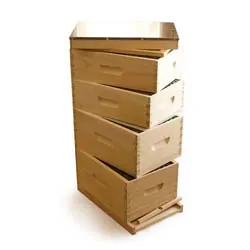For beekeepers who have harvested their honey for the year, a choice must be made regarding how to package and present your harvest. While standard glass jars or the ubiquitous plastic squeezable honey bears are hard to beat, sometimes sample – offering smaller, less expensive options – are in order. Even if you’re not a beekeeper, you’ve perhaps come back from local farmer’s market with more honey than you know what to do with!
Making honey sticks, also known as honey straws, can be a fun activity both in regards to the making of the sticks themselves, to having them on hand for a quick snack and treat. Let’s take a quick look at how to make honey sticks.
Equipment Needed
• Non-crystalized honey
• Honey Container with small spout or food syringe
• Plastic Straws
• Scissors
• Heat Sealer, or 2 Pairs of Pliers and a Candle
The Process
Use Warm Honey
To make the whole process easier, you’ll want to do this with warm honey. Honey of 80 degrees Fahrenheit or above will make the honey more viscous and easier to work with.
But not too hot! If you’re working with raw honey you don’t want to cook it! It’s best to stay under 100 degrees. Processed and filtered honey has already been heated above this point, but we aren’t looking to heat our honey up too much – we want it to be liquid but not runny.
The best way to warm your honey is to soaking a container in a warm bowl of water before you start. This is a situation where it may be best to work with processed honey that won’t crystalize. While crystalized honey (raw honey that has solidified) that you can still scoop with a spoon in a jar is one thing, crystalized honey in a straw will be tough to use. Long story short…if you do this with raw honey, use your honey sticks quickly!
Preparing The Sticks
To begin, cut the straw if desired to your preferred length, although you can often use the entire straw for larger honey sticks. Holding the straw horizontally, fill the straw with honey until the honey is around half an inch from the far end of the straw.
If you have a plastic honey bear-style bottle with a tapered tip, you’re already in business Alternatively some flip-top bottles that have a small spout will be workable. If you’re looking to step up a level, a sterile syringe (no needle) will offer more precision and result in less mess.
Next, seal the far end of the straw. If you have a heat sealer already on hand, which are commonly used to seal and preserve vacuum sealed foods for your freezer or dry stage, this will be your best bet.
However, you can also accomplish this by using a tea light candle and 2 pairs of clean needle-nose metal pliers.
Hold the straw with one pair of pliers, about a quarter inch in from the end. Then, moving the tip of the straw near the candle flame, you can start to melt the very end of the straw. Don’t hold it too close or the straw may catch on fire.
Still holding the straw with your first pair of pliers, you can then crimp the end of the straw with the other pair of plier jaws (before it cools) to seal the straw. Be careful though! Hot melted plastic, hot plier jaws, and candle flames can all cause serious burns.
Sealing The End
Regardless of your preferred tools, once you have one end of the straw sealed you’re ready to seal the end in which you inserted the honey. With one end now sealed, turn this sealed end down and tap any honey towards the sealed bottom of the straw. If you’ve done things right, your straw should be completely filled except for about half an inch at the top.
Repeating the process you used to seal the bottom of the straw, seal the top. You should now have a completely filled and sealed straw. Set aside to cool.
Gently squeeze the straw once cooled to test the seal. Repeat until you’ve made your desired number of honey sticks.
Coloring or Adding Flavor
Some people take things a step further by add food-coloring or flavors to the honey. If you’re looking for variety this is certainly one way to go about it. But, as beekeepers, we believe there’s a lot to be said for keeping all that work the bees have done as it is, leaving the honey to shine through all on its own straight from the hive.
And remember the harvest from each year is a little different, and every honey unique.
Once you’ve spent a morning or afternoon making your honey sticks, you’ll now have a fun way to share your honey with others in small amounts, offer samples, or create an easy snack for yourself.
